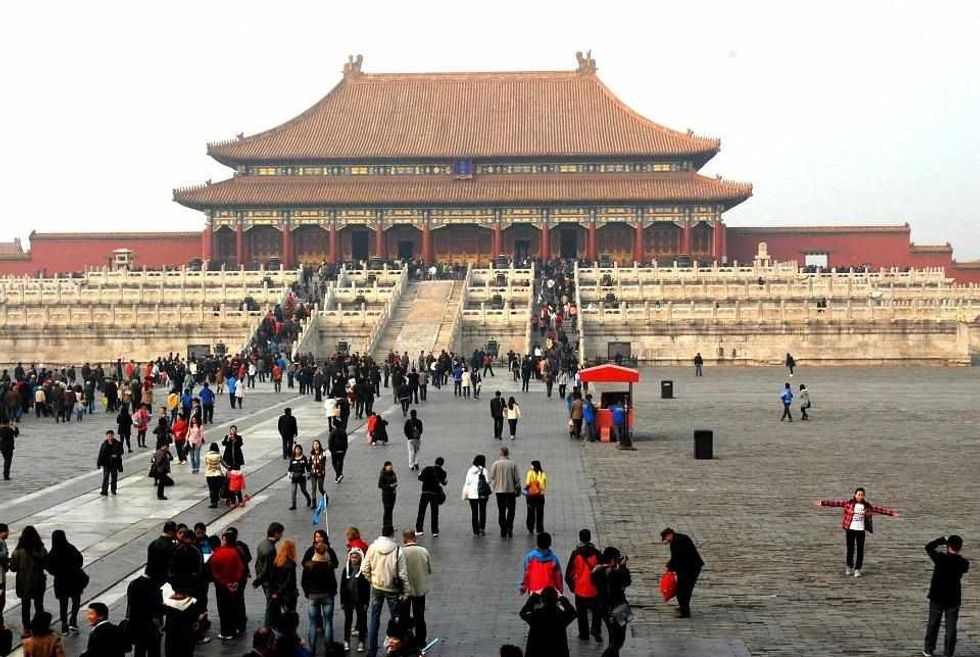The Imperial palace in the Dongcheng District of Beijing, China is referred to as 'The Forbidden City.'
The erstwhile palace was the Qing dynasty's architectural achievement under Manchu. It was constructed in 1625 and was formerly called the Imperial Palace of the Qings.
The Forbidden City is surrounded by several opulent imperial temples and gardens, including a 2,368,060 sq ft (219,999.9 sq m) Zhongshan Park, a 7,427,098 sq ft (690,000 sq m) Beihai Park, the Imperial Ancestral Temple, and a 2,230,272 sq ft (207,199 sq m) Jingshan Park.
From 1406-1420, it was designated as the former imperial winter palace and residence of the Ming dynasty for the Emperor of China. It was there until the end of the Qing dynasty, and it served as a place for Chinese emperors.
Today, it stands as one of the most precious museums displaying cultural relics in China.
The rectangular palace of The Forbidden City covered around 7,965,294.4 sq ft (740,000 sq m). It had 9,999.5 rooms and was 2,493.4 ft (760 m) in width, and 3,152.8 ft (961 m) in length. During the Qing dynasty, the imperial family was eliminated in 1924, and a museum was later established in 1925.
The first three emperors of the Qing dynasty lived in the erstwhile palace between 1625-1644. But, after the imperial rule collapsed in China, this location was converted into a museum. The Forbidden City is one of the most popular tourist attractions in China.
Architectural Design
There are different entrance gates in the Forbidden City: to the south, there is the main Wumen and Shenwumen, and Donghuamen. To the north is the Inner Palace (Nesting), and to the south is the Front Palace (Qianchao). Three solemn and magnificent halls are there in the Front Palace: Zhonghedian, Taihedian, and Baohedian.
The Imperial Palace of the Qing dynasty and the erstwhile palace retained several characteristics of the traditional residences during construction. The structure follows a unique social system of Manchu, an 'eight-banner' system, and follows a proper arrangement throughout the palace buildings.
A wall of 32.8 ft. (10 m) high with a moat of 171 ft (52 m) surrounds The Forbidden City. The Inner Palace and Buddhist sanctuaries make the entire location mesmerizing. It has unique features of scientific, historical, and artistic value.
History & Cultural Significance
The Forbidden City was built by a million craftsmen and included precious Phoebe Zhennan wood. The floors were paved using golden bricks. In October 1644, Manchus claimed supremacy in northern China. In 1860, the Anglo-French army took possession of the place during the Second Opium War.
In 1933, the evacuation of the national treasures by the Japanese invasion of China happened. However, some of the collections were handed over to Beijing at the end of World War II. It was during this time that the palace endured a lot of damage.
The erstwhile palace is a replica of The Forbidden City. It exhibits hints of Tibetan and Manchu styles.
This palace lost its status after the Ming dynasty made room for the Qing dynasty in Beijing in 1644. After that, it became a regional palace and was expanded by the Qianlong Emperor in 1780. Later, it was transformed into a museum in 1955.
The royal palaces contain some examples of the architecture in Chinese civilization. The palace's design shows the transition of Chinese palace aesthetics from the traditional architecture that happened 350-450 years ago. During the Qing and Ming dynasties, the palaces represented the cultural heritage of China. They preserve architecture, landscapes, artifacts, furnishings, and show the evidence of Shamanism.
The inner palace of ancient China is an example of royal architectural ensembles. The Qing dynasty, along with the Yuan and Ming dynasties, illustrated the traditions of Manchu and showed the evolution from one century to another.

A World Heritage Site
In 1987, UNESCO declared The Forbidden City a World Heritage Site after the development of its cultural traditions and relics. They named it the Imperial Palace of the Qing and Ming dynasties. In 2004, the Shenyang Imperial Palace was included on the World Heritage list by UNESCO.
At present, a 16-year restoration project is going on that is being administered by the Palace Museum.
Protection & Management
The palaces, The Forbidden City, and the Imperial Palace have been well protected over the past centuries. In 1925-1926, the two palaces were declared as the Palace Museums after the Qing dynasty's collapse. They were placed on a special list in 1961 and were protected after their repair.
The officials of China followed strict implementations, and around 148,217,256 sq ft (13,769,833 sq km) were declared as a buffer zone. The higher authorities and the government of Shenyang stated the rules and regulations to protect the palace.
All of these things ensured the integrity and authenticity of the property. It also ensured the safeguarding of the cultural heritage sites and architectural art for tourists.
Other Miscellaneous Facts
The religious buildings were home to 24 emperors who resided there for over 500 years. Other noteworthy facts include:
The art treasures of the palace include pottery, paintings, bronze wares, silver and gold wares, lacquer enamel wares, embroidery, inscribed wares, sculptures, jade wares, and lacquer enamel wares. Besides that, there are accessories, jewels, clocks, furnishings, medicines, and clocks.
There is a superb and unique building complex that shows the outstanding achievements of early Chinese architecture. After establishing this palace, Beijing became one of the important locations for discussing political and military affairs.
'The Forbidden Metropolis' was intended to be the focal point of Beijing's historic, walled city. It is surrounded by a bigger, walled region known as the Imperial City.
The architectural arrangement represents the inbuilt features of urban planning. It features an asymmetrical design, a central axis, and an inner and outer court layout at its front and rear end, respectively.
The Forbidden City has followed symmetrical structure in its building arrangement. The imperial power is represented by the throne located at the center of the central axis.
The construction of the royal palace was started by Nuerhachi in 1559 and was finished by Huangtaiji, his son, in 1643. They were considered the Qing dynasty's founding members. It was the final dynasty of China founded by the aristocrats of Manchu who were overthrown in 1911.
The Forbidden City features the Han culture and highlights the Manchu residents. These structures are typically in style and originated from the hunting process of the Manchu tribes.
Tourists worldwide visit the Palace Museum to explore the earlier dynasties of China. It shows how the emperors of China endured during those times.
FAQs
When were the Imperial Palaces of the Ming and Qing dynasties built?
A: The Imperial Palaces of the Ming and Qing dynasties were built between 1406-1420 and 1625, respectively.
Who built the Imperial Palaces of the Ming and Qing dynasties?
A: Zhu Di, the Ming Emperor, built the Imperial Palaces of these dynasties.
Where are the Imperial Palaces of the Ming and Qing dynasties located?
A: The Imperial Palaces of these dynasties are located in the Dongcheng District in China, and Shenyang, Liaoning.
What is the significance of the Imperial Palaces of the Ming and Qing dynasties in Beijing and Shenyang?
A: The significance of the Imperial Palaces of the Ming and Qing dynasties in Beijing and Shenyang is that they were the residences for the royal family and were the center of state power.
When and why were the Imperial Palaces of the Ming and Qing dynasties in Beijing and Shenyang declared as a World Heritage Site?
A: In 1987, The Forbidden City was declared by UNESCO as a World Heritage Site. In 2004, the extension of The Forbidden City, including the Shenyang Imperial Palace, was declared the same by UNESCO.
Why are the Imperial Palaces important to China?
A: The Imperial Palaces are important to China because they contain an important library and memorialize China's last dynasty.









